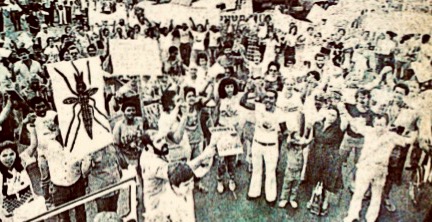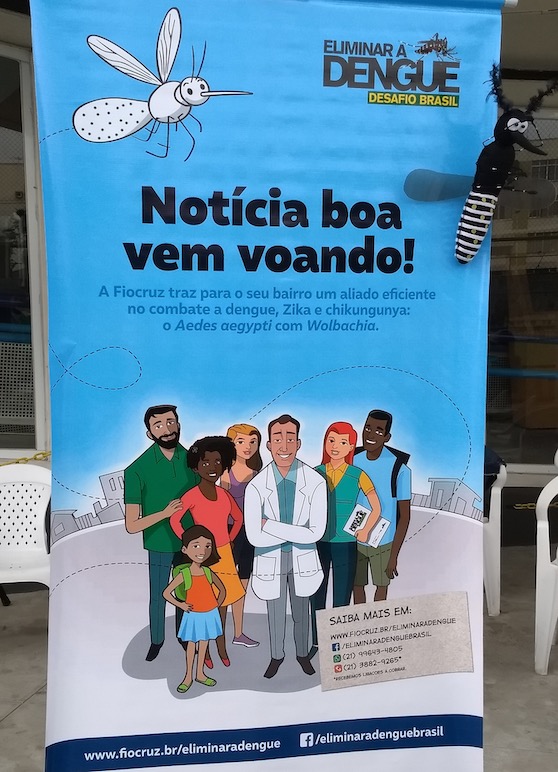Mosquito: the “most dangerous animal in the world,” human’s “deadliest predator.” This insect is often described as the most probable target for gene-editing technologies that have the potential to eliminate the unwanted. Mosquitoes are usually presented as the number one enemy of humankind, a globally hated pest: the most killable of all beings.
Last year, I participated in a multi-disciplinary symposium at the Rachel Carson Center in Munich, Mosquitopia? The place of pests in a healthy world. The event’s organizers, Marcus Hall and Dan Tamir, prompted us to reflect on the questions of how, where, what, if, and should mosquitoes be controlled, even eradicated.
This piece is based on my presentation at the Mosquitopia symposium: a reflection about what is, after all, the place of mosquitoes in a healthy (human?) world. There are many paths one could take to try to address this matter (as, indeed, the diversity of presentations in the event showed). I propose that we first interrogate and destabilize the general, amorphous categorization of mosquitoes. To illustrate the mosquito’s multiplicity, one could point to the various species within the category, creatures that populate diverse ecosystems across the world—and of which only a small fraction can transmit harmful pathogens.
However, I choose to focus on just one particular species: the Aedes aegypti, the infamous vector of viruses, including Zika, dengue, chikungunya, and (urban) yellow fever. Here, I emplace contemporary discussions about mosquito-borne diseases and, in particular, a proposed solution to deploy modified mosquitoes within a notable genealogy of mosquito preoccupation in Brazilian politics. By zeroing in on only one species, I show how the A. aegypti has been perceived and tackled in varying ways, arguing it matters how these insects are framed, and by whom, and how these different mosquito understandings shape the historical and social conditions of efforts to control both these insects and the pathogens they can transmit.

Lateral view of the female Aedes aegypti mosquito. Source: “Description of the Anti-Aegypti Technique, 1943,” The Fred L. Soper Papers, Courtesy of the U.S. National Library of Medicine, National Institute of Health.
Pathogens and Priorities
As the symposium organizers reminded us, climate change is expanding the geographical spread of insects like the A. aegypti, ushering a new mosquito epoch in certain parts of the world. However, for people living in warmer regions of the planet, these buzzing, biting critters have been a question for a long time. As part of my collaborative project with historian Gabriel Lopes, we examined how the A. aegypti has had a historical trajectory spanning more than one hundred years in Brazil.
This mosquito is entangled in the violent histories of slavery and settler colonialism that constitute the country. Environmental historians have described how the A. aegypti probably arrived in the lands referred now as Brazil in the same ships that have crossed the Atlantic forcibly bringing enslaved people and carrying expropriated natural resources away.Nevertheless, it was only at the beginning of the 20th century, once researchers had established that the mosquito was the vector for yellow fever, that the insect became the target of public health campaigns. During the first decades of the 20thcentury, medical and political (white) elites in Brazil called for the treatment and prevention of diseases as a fundamental step towards overcoming the country’s “backwardness” and as a means to “modernize” the nation (Löwy 2005). This plan took its lead from public health and scientific narratives that claimed the environment could influence the moral and physical makeup of its citizens.
Hence, controlling diseases like yellow fever could “civilize,” or “improve,” the country’s population—a project historian of science Nancy Leys Stepan (1991) has defined as “soft eugenics,” the idea that race could be “ameliorated” through social and environmental transformation. In addition, some politicians and public health officials also saw controlling yellow fever as pivotal for enforcing racist “whitening” policies that promoted the immigration of (white) Europeans to Brazil (see also: Nascimento 1989), since the new immigrants/settlers were considered to be particularly susceptible to the virus.
In the 1980s, the A. aegypti once again became the target of public health campaigns, this time for its role in transmitting the dengue virus. The mosquito, which had been eliminated from Brazil in the 1950s, had made its way back into the country during the years of dictatorship: the military government, which ruled Brazil from 1964 to 1985, had dismissed reports of the mosquito’s return, discrediting the scientist, Habib Fraiha, who sounded the alarm. The arrival of the dengue virus made noticeable how the A. aegypti was already present throughout the sprawling cities across the country. With the extensive spread of the mosquito, dengue cases quickly mushroomed.
Those affected by the disease, in particular residents of lower-income neighborhoods in the outskirts of Rio de Janeiro, protested the outbreaks, which they saw as a result of the government’s historical disregard for their well-being, and especially for their health and sanitary conditions. These demonstrations occurred during the “redemocratization” process, with protesters demanding a broader understanding of health and healthcare access as a state assured right (Pires-Alves, Paiva, and Lima 2018). These ideas, embedded in the dengue outbreak protests, would become part of a national debate about healthcare and the creation of the 1988 Sistema Único de Saúde (SUS), the national, public, universal health system.

Black and white photo of protestors closing a road holding banners, with a line of vehicles behind them.
Source: “Moradores da Baixada fecham a Via Dutra” [Baixada Residents block the Via Dutra]. Rio de Janeiro, May 28 1986, O Globo. [I am thankful to Gabriel Lopes for this image.]

Black and white photo of protestors, some are holding signs and, most notably, one of them has a mosquito image. Source: “Multidão para Dutra e pede estado de calamidade na Baixada” [Crowd blocks Dutra and asks for a declaration of state of emergency in the Baixada], Rio de Janeiro, May 28 1986, Fluminense. [Again, I am thankful to Gabriel Lopes for this image.]
The continuous spread of the virus and consistent frequency of dengue outbreaks in Brazil led people to refer in campaigns and in the media to the A. aegypti, formerly known as the “yellow fever mosquito,” as the mosquito da dengue, or “dengue mosquito.” The insect and the dengue virus had become commonplaces in Brazilian urban landscapes. The insect had become a commonplace of Brazilian urban landscapes. Despite policies and strategies to control the A. aegypti, the mosquito continued to proliferate in cities, transmitting the dengue virus and, after 2014, the chikungunya virus. Outbreaks of these diseases became almost an expected urban public health issue in the country.
However, in late 2015-early 2016, the mosquito regained notoriety for being the vector of a different pathogen: Zika. The virus was linked to congenital issues in fetuses and newborns, most notably microcephaly. The somatic effects of the Zika virus and the recommendation for “women to postpone pregnancy” during the epidemic brought forward debates about reproductive justice in Brazil. Abortion is a crime in the country, except in cases of rape, risk to mother’s life, and anencephalic fetuses. However, those who can afford it pay for a clandestine but medically safe procedures and are rarely prosecuted.
Zika was mobilized by both feminists and conservative groups: the first argued for the need to decriminalize/legalize abortion as a social justice issue since poor, mostly black and brown, women were unequally harmed by both the procedure’s illegality and the impacts of Zika; while the latter argued for the need to further hamper access to abortion since it could be used as an “eugenic tool” against disable children, like those with Congenital Syndrome Associated with Zika Virus Infection (Lira, Meira, and Campos 2018). Furthermore, the Zika epidemic happened during a time of intense political polarization in the country, intensified by the coup/impeachment of the President Dilma Rousseff. While still in power, the Rousseff administration had tried to use the “fight against the mosquito” to unite the country against a common “enemy” and to show itself as a determined, combative government; however, Rousseff’s opposition used the epidemic and broader deficiencies of the Brazilian public health system as evidence of the state’s managerial incompetence.
These three historical moments demonstrate how the same mosquito, the A. aegypti, has been considered a pest for different reasons: for Brazilian elites, as hindering “civilizing” and “whitening” endeavors; for social advocates, as reinforcing social inequalities and uncovering governmental disregard; and for politically polarized citizens, as escalating divisions about reproductive rights and the role of the state. The distinct viruses that were transmitted through the mosquito’s bites as well as the political context in which these bites occurred shaped what kind of vector A. aegypti became. These different mosquito understandings shaped how the priorities of disease control were defined and how the endeavors to tackle illness by controlling the mosquito were perceived. To put it differently, what was imagined as a “healthy world” in efforts to eliminate the A. aegypti greatly varied in each case.
Beyond a Vector
The mosquito can thus be a different kind of vector depending of the pathogen it carries and the priorities in place. In certain situations, however, the A. aegypti may not even be considered a pest. For example, Túllio Maia’s (2020) ethnographic research has described how, for the sertanejos—those living the non-urban areas of the Brazilian northeast countryside—mosquitoes like the A. aegypti did not “cause disease.” These sertanejos ascribed diseases like Zika as being transmitted by mosquitoes only in cities, with their dirt, trash, and sewage. Away from the urban context, mosquito bites were not seen as a vehicle for pathogenic viruses, but rather as part of the insect’s struggle to survive the arduous environment in the sertão, in the same way that the sertanejos, and other inhabitants, were also continuously striving to survive.
Finally, within my dissertation research examining new technologies for addressing mosquito-borne diseases in Brazil, I conducted fieldwork with a group releasing modified A. aegypti throughout the city of Rio de Janeiro. This global health group, the World Mosquito Program (WMP), is one among different projects across the world now trying to use the mosquitoes themselves to control the pathogens they can transmit. [1]
Implemented in Brazil by Fiocruz researchers, the project releases A. aegypti infected with the bacterium Wolbachia, a microbe that can inhibit the insect’s ability to transmit pathogens. Wolbachia-infected mosquitoes are expected to mate with the so-called “wild ones” and pass on the bacteria to the next generation. In other words, the goal is to turn mosquitoes from vectors to non-vectors; or, as one of my interlocutors put it, to create a conceptual shift: the “problem to be controlled” is no longer the vector but the virus and, by becoming non-vectors, the A. aegypti infected with Wolbachiaare transformed into “allies” in efforts to tackle diseases.

Banner from the WMP project. On the upper right side, it is written “Eliminar a Dengue – Desafio Brasil” (Eliminate Dengue – Brazil’s Challenge), which is the name WMP used in its early days. On the upper left side, there is a white mosquito with green dots. In the middle, in bold, it is written “Notícia boa vem voando” (Good news arrive flying); then, beneath, in smaller font, “A Fiocruz traz para o seu bairro um aliado eficiente no combate a dengue a dengue, Zika e chikungunya: o Aedes aegypti com Wolbachia” (Fiocruz brings to your neighborhood an efficient ally in combating dengue, dengue, Zika and chikungunya: the Aedes aegypti with Wolbachia).
Source: Photo by the author. Rio de Janeiro – December 08, 2017.
The releases of Wolbachia-infected mosquitoes are happening in Rio de Janeiro, where the local government declared bankruptcy and where, during my fieldwork, government-paid public health agents who collaborated with the WMP were on strike for not receiving their salaries. Furthermore, the violence of conflicts in Rio has been escalating in the last years, with shootings and gun fights between drug dealers, milicianos (paramilitary, mafia-style groups), and police/military forces occurring regularly, often with fatal outcomes, especially in the favelas and periferias of Rio, which are low-income and mostly Black communities.
Rio’s public financial deficiencies and widespread violence not only complicated logistics but it also introduced questions about the release of Wolbachia-infected A. aegypti as a public policy priority. Or as a favela resident put it during a WMP “public engagement,” “Dengue might kill, but do you know what really kills here? It is the ‘stray bullets,’ which always end up somehow finding their way into our black bodies.”
Perhaps the point made by this poignant remark is not about having to choose between either implementing technological solutions to health problems, or addressing historical issues of inequalities and racism, but how priorities are set and, most importantly, how health is understood. After all, a “healthy world” is not only one in which people are not experiencing the harmful effects of dengue, Zika or chikungunya viruses on their bodies but also a world in which people do not have to live under the sound of police helicopters and machine guns.
Placing Mosquitoes
Placing mosquitoes—that is, putting these insects in particular places, positions, and contexts—demonstrates how even one species can be embroiled in different narratives, debates, struggles, and agendas, and how, concomitantly, these different A. aegypti framings shape multispecies perceptions and interactions and, more specifically, vector control efforts. To understand the place of mosquitoes, I draw from the various anthropologists, geographers, and other social scientistswho have long described how “place” is not bounded, static nor singular, but a social, political, historical, and uneven process always changing and in-the-making. The presence of the A. aegypti and mosquito-borne diseases in Brazil, or in any part of the world, cannot be dissociated from the histories that shape those environments and societies. Anthropologist Alex Nading (2014) defines these connections in terms of the “politics of entanglement,” the complex knots of people, mosquitoes, environment, and social, cultural, and medical practices.
By describing these various understandings of the A. aegypti, a species notorious for its role in transmitting pathogenic viruses, I showed how it is important to examine the ways in which places make mosquitoes and mosquitoes make places. This piece is also a reminder that any project that might consider eliminating mosquitoes, or any other effort to address mosquito-borne diseases, should reflect on who is implementing the project, where and how is it being developed, who is affected by it, and what the motivations/support is for choosing the project. Place—and, consequently, what is considered a “healthy world”—matters when considering the place of mosquitoes.
Notes
[1] Other strategies include genetic modified mosquitoes, either transgenic or gene-drive ones, as well as irradiated mosquitoes.
References
Lira, Luciana Campelo, Fernanda de Souza Meira, and Roberta Bivar C. Campos. 2018. “Tensões e (Re)Elaborações Sobre Gênero e Deficiência No Debate Sobre Aborto: Reflexões Etnográficas No Contexto Da Síndrome Congênita Do Zika Vírus.” Paper presented at the 31st Brazilian Anthropology Meeting (RBA), Brasília, December.
Lopes, Gabriel, and Luísa Reis-Castro. 2019. “A Vector in the (Re)Making: A History of Aedes Aegypti as Mosquitoes That Transmit Diseases in Brazil.” In Framing Animals as Epidemic Villains, edited by Christos Lynteris, 147–75. London: Palgrave Macmillan.
Löwy, Ilana. 2005. Vírus, Mosquitos e Modernidade: A Febre Amarela No Brasil Entre Ciência e Política. Translated by Irene Ernest Dias. [2001]. Vol. 23.
Maia, Túllio Dias da Silva. 2020. “The Mosquito Struggle: Other-than-Vector Ecologies in a ‘Zika-Free’ Brazilian Sertão.” Somatosphere: Science, Medicine, and Anthropology – Histórias of Zika Series. 2020.http://somatosphere.net/2020/mosquito-struggle-zika.html/. Accessed March 2, 2020.
Nading, Alex M. 2014. Mosquito Trails Ecology, Health, and the Politics of Entanglement. Berkeley: University of California Press.
Nascimento, Abdias do. 1989. Brazil, Mixture Or Massacre?: Essays in the Genocide of a Black People. Dover, MA: Majority Press.
Pires-Alves, Fernando Antônio, Carlos Henrique Assunção Paiva, and Nísia Trindade Lima. 2018. “Na Baixada Fluminense, à Sombra Da ‘Esfinge Do Rio’: Lutas Populares e Políticas de Saúde Na Alvorada Do SUS.” Ciência & Saúde Coletiva 23 (6): 1849–58.
Stepan, Nancy Leys. 1991. The Hour of Eugenics : Race, Gender, and Nation in Latin America. Ithaca: Cornell University.
Acknowledgements
I am thankful to Marcus Hall and Dan Tamir for all their work organizing the Mosquitopia Symposium, the Rachel Carson Center for hosting us, and all the participants of the event for their insightful remarks on my presentation, for sharing their own fascinating work, and for all the engaging mosquito-minded conversations during our four days in Germany. Harriet Ritvo, Stefan Helmreich, and Túllio Maia offered thoughtful comments to earlier versions of this piece. Mel Ford and Baird Campbell were incredibly helpful throughout the editorial process for this post. Thank you also to the Rede Zika Ciências Sociais for all their support, especially during my stay in Rio. My fieldwork research accompanying the implementation of Wolbachia-infected mosquitoes in Rio de Janeiro was supported by an International Dissertation Research Fellowship from the Social Science Research Council; a Doctoral Dissertation Research Improvement Grant (BCS-1823376) from the National Science Foundation—Cultural Anthropology Program; and a Dissertation Fieldwork Grant (Gr. 9677) from the Wenner-Gren Foundation.

1 Trackback